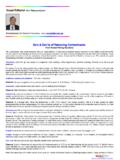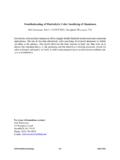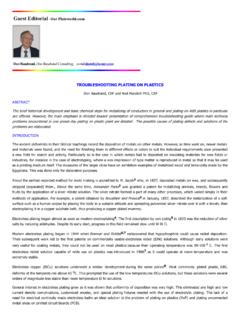Transcription of Surface Metal Plating - FrontierMaterials.net
1 What is a Surface Finish?A Surface finishmay be defined as a coating located at the outermost layer of a PCB (which is dissolved into the solder paste upon reflow or wave soldering)(which is dissolved into the solder paste upon reflow or wave soldering)Two Main Types of CoatingsFinishSurface Metallic OrganicMetal PlatingFinishNote: (Base) Metal Plating is typically copper (in most cases). g()gypypp()But, in a few (like ENIG) the nickel -phosphorous (5-12% P co-deposit) serves as the solderable use a Surface Finish?The Surface finish protects the PCB Surface Copper until it s AssembledHow to Select a Proper Surface Finish?Reasons for FinishesReasons for Finishes Coplanarity (See Below) Lead-Free (RoHS and WEEE) (RoHS 5 or RoHS 6) Contact Resistance (Compression Connection) Tarnish Resistance Press-fit Requirementsq Wear Resistance Hardness Chemical Resistance Chemical Resistance Wire Bonding (Au or Al?)
2 Cost Compatibility with other Surface FinishesSurface Finish Cost Comparison$10 00 Surface FINISH COSTS$ $ $ $ $ $ $ $ $ $ $ per Sq Ft*Cost per PanelCost per Sq FtCost per PanelOSP (-C)OSP (-NC)I-Tin (-NC)I-Tin (-C)I- Silver (-C)HASL (- C)HASL (- NC)ENIG (-NC)Ni-Pd-Au (-NC)*Source: Cisco Systems-C: Conveyorized Process-NC: Non-Conveyorized ProcessResistivity of PCB Metals70805060 cm3040u ohms /1020u010 SilverCopperGoldNickelTinTinLeadEless nickel PhosSource: *1 Galvanic Series - Electromotive ForceGoldGold+ Volts+ VoltsPlatinumIridium PalladiumSilverSilver+ + + + VoltsLeadTinMolydenumNickel - Group I Group II Group III Group IV Group VMagnesium Aluminum 2S Lead-tin Solder Copper- nickel GraphiteZinc Cadmium Lead Monel GoldGalvanic Steel Aluminum 17ST nickel Silver Solder PlatinumSteelBrassNickel (passive)Steel Brass nickel (passive)Iron Copper Stainless SteelMetals can cause noise voltage due to a galvanic reaction between two metals.
3 (Positive ions from one Metal can be transferred to the other)(Positive ions from one Metal can be transferred to the other) The farther apart the metals are in the series, the faster the rate of corrosion (fretting). When dissimilar metals must be combined, try to use metals from the same series Finish TypesMetallic Coatings:HASL (Hot Air Solder Level)ENIG (Electroless nickel /Immersion Gold) electrolytic Ni /Au ( electrolytic nickel / Gold) electrolytic Ni /Au ( electrolytic nickel / Gold)Imm Ag (Immersion Silver)Imm Sn (Immersion Tin)Reflow Tin/LeadElectroless nickel /Palladium-Immersion GoldSelective Solder Strip (SSS)Selective Solder Strip (SSS)Sn Ni (Tin- nickel )Unfused Tin/LeadNot commonElectroless nickel -Immersion PalladiumOrganic Coatings:OSP (Organic Solderability Preservative)OSP (Organic Solderability Preservative)Carbon Ink (Screened on)(Or combinations of the two - OSP and Selective ENIG or Hard Gold)Electroless Plating (Only) Process is nonelectrolytic.
4 (No electrical current applied)Mtliddbh ilith ltilti Metal ions are reducedby chemicals in the Plating solutions. Depositsare from a process that continues once it is started (autocatalytic).Depositsare from a process that continues once it is started (autocatalytic). A uniform coatingthat can be applied on irregularly shaped features. Applied by rack(in a batch process). Deposits are generally harder, more brittle and more uniform than electroplated PlatingElectroless nickel (Depicted Below)Electroless nickel (Depicted Below)Ni ++NiCuElectroless Ni / Electroless GoldTypical Thickness: m (10 - 50 in) Electroless Gold over 3 6 m (120 - 240 in) Electroless NickelADVANTAGES+Gold WireBondableDISADVANTAGES-Solder Joint Embrittlement+ Gold Wire-Bondable+ Planar Surface + Consistent Thicknesses-Solder Joint EmbrittlementPotential When Incorrectly SpecifiedNi/S S ld j i+ Multiple Thermal Cycles+ Long Shelf Life-Ni/Sn Solderjoint-Difficult to Control-Cannot be Reworked by Faby-Expensive-Lab Support ExtensiveENIG (Electroless and Immersion Plating )Typical Equipment used for the Plating of ENIGA utomated ENIG Plating Line (PAL)Electroless and Immersion PlatingENIG (Depicted Below)ENIG (Depicted Below)
5 Electroless Ni/Electroless Palladium-Immersion GoldNi ++Ni +Au ++ThNiNiThenCuNiNiCElectroless nickel PlatingImmersion Gold PlatingCuCuENIG (Electroless nickel /Immersion Gold)Typical Thickness: 0 05023 m(29 in) Gold overTypic al Thickness: m (2 -9 in) Gold - m (100 200 in) Electroless NickelADVANTAGES+Planar SurfaceDISADVANTAGESNot Gold WireBondable+Planar Surface +Consistent Thicknesses+Multiple Thermal Cycles-Not Gold Wire-Bondable-Expensive-Suspect Issues with Grid Array Packages( i/S Sj i )+Long Shelf Life+Solders Easily+Good for Fine Pitch Product(Ni/Sn Solderjoint)-Waste Treatment of nickel -Cannot be Reworked at PCB Fabricator-Waste Soldermask Compatibility-Not Optimal for Higher Speed Signals-Lab Support ExtensiveLab Support ExtensiveElectroless Ni/Palladium-Immersion GoldENIPIGT ypical Thickness.
6 M (1 - 2 in) Gold over m(8 - 24 in) Pd over 5 m (100 - 200 in) nickel ADVANTAGESDISADVANTAGES+Palladium Prevents nickel from Passivating in the -Additional Process Step for PCBF abricator; Added Cost ResultsPresence of the Porous GoldDeposit+Aluminum Wire Bondable-Possibly Issues with Solder Pot on Wave-Waste Treatment-Ni/Sn Solderjoint+Flat / Planar Surface +Good for Fine Pitch Product+High Reliability / MilitaryNi/Sn Solderjoint-Lab Support Extensive-Very Expensive+High Reliability / MilitaryImmersion Plating Chemical reactionis used to apply the coating. Metal ionsare reduced by chemicals into the Plating solutions. Then a uniform coatingcan then applied to irregularly shaped features. Applied by a rack(in a batch process).Immersion PlatingGalvanic DisplacementSimply anSilver (Depicted Below)TinGalvanic Displacement -Simply an Exchange of Copper and Silver Atoms; No Reducing Agent RequiredAg ++Cu ++Ag ++CuBase Foil + Plated CopperImmersion Silver PlatingTypical Equipment used for HorizontalTypic al Equipment used for HorizontalImmersion Silver PlatingConveyorized Horizontal Immersion Silver Plating LineSmaller Proto Shops may use a Vertical Batch Process Immersion Ag (Immersion Silver)Typical Thickness: 0 15045 m(618 in)Typic al Thickness: m (6 18 in)ADVANTAGESDISADVANTAGESADVANTAGES+ Good for Fine Pitch Product+Planar S rfaceDISADVANTAGES-High Friction Coefficient.
7 Not Suitedfor PressPin Insertion (NiAu Pins)+Planar Surface +Inexpensive+Short, Easy Process Cyclefor Press-Pin Insertion (Ni-Au Pins)-Some Difficulty Plating Into uVias with Aspect Ratios > .75:1 Miid C+Cu/Sn Solderjoint+Doesn t Affect Hole Size+Can be reworked/Re-applied by-Micro-voids Concerns-Corrosion Must be Controlled(Sensitive to Cl- and S-)Can be reworked/Reapplied bythe PCB Fabricator-Handling ConcernsImmersion Tin PlatingTypical Equipment used for the Immersion Tin PlatingTypic al Equipment used for the Immersion Tin PlatingAutomated Immersion Tin Plating LineImmersion Sn (Immersion Tin)Typical Thickness: 0 616 m(2560 in)Typic al Thickness: m(25 -60 in)ADVANTAGESDISADVANTAGES+ Reliability Testing ResultsComparable to ENIG-Panels Must be Routed and TestedPrior to Coatingp+ Good for Fine Pitch Product+ Planar Surface + Cu/Sn Solderjointg-Contains Thiourea, a KnownCarcinogen-Limited Rework Cycles at CMj+ InexpensiveLimited Rework Cycles at CM-Horizontal Process Needs Nitrogen BlanketToo Viscous for Small Holes;-To o Viscous for Small Holes.
8 Backpanels Only-Handling ConcernsImmersion Palladium (Pd)Typical Thickness: 0 1 m10 m(4400 in)Typic al Thickness: m 10 m (4 -400 in)ADVANTAGESDISADVANTAGES+ Good Solderability+Cu/Sn Solderjoint-Availability-Possibly Issues with Solder Pot on Wavej+Used in Automotive Sector-Handling ConcernsElectrolytic Plating electrolytic platingis achieved by passing an electric current thhl tit i idil dt l ithrough a solution containing dissolved Metal ions. The PCB panel then serves as the cathodein an electrochemical cell attracting the dissolved Metal ions from the solutioncell, attracting the dissolved Metal ions from the solution. The processincludes controlling of Plating parameters including voltage and amperage temperature time and purity ofvoltage and amperage, temperature, time, and purity of bath solutions.
9 Operatorsrack panelsthat carry the part from bath to bathOperators rack panelsthat carry the part from bath to bath (in a batch process). electrolytic PlatingElectrolytic nickel -Gold (Depicted Below) electrolytic nickel -Gold (Depicted Below)-++++-PCBN ickePCBThenTitaniAdAdelAdAdGoldSolutionN ickelSolutioniumAnodeAnodeCathodeElectro lytic nickel PlatingAnodeAnodeCathodeElectrolytic Gold Plating (ONi k l)(Over nickel ) electrolytic Plating of nickel an GoldTypical Equipment used for the electrolytic Plating of nickel and GoldAutomated nickel and Gold Plating LinegPAL and TAB Lines ShownElectrolytic (Hard) nickel / GoldTypical SMT Thickness: 0 2508 m(1030 in) GoldTypic al SMT Thickness: m(10 -30 in) Gold over 8 m (100 - 300 in) nickel ADVANTAGESDISADVANTAGESADVANTAGES+ Plated Ni/Au Can be Used as an Etch ResistDISADVANTAGES-Exposed Cu SidewallsNickel Slivers Likely After S E Sas an Etch Resist+ Available for MixedTechnology Products- nickel Slivers Likely After Process-Poor throwing Power+ Au Wire-Bondable+Long Shelf LifeTypical GF Thickness: m (30 - 60 in) Hard Gold over 8 m (100 - 300 in) nickel Selective Solder PlatingTypical Equipment used for the Solder PlatingTypic al Equipment used for the Solder PlatingManual Tin-Lead Plating LineSelective Solder Strip (SSS)Typical Thickness.
10 7 20 m (300 - 800 in)ADVANTAGESDISADVANTAGESADVANTAGES+ Hot Bar Reflow for TABDiDISADVANTAGES-Multiple Resist and Photo CyclesDiffilt i Ct lliPl t dDevices+ Alternative to HASLon Thick Product-Difficulty in Controlling Plated Sn/Pb Thickness-Overlap (Butt) Line Difficult to Control-Expensive-Contains LeadContains LeadDip CoatingsHASL (Hot Air Solder Level)HASL (Hot Air Solder Level)OSP (Organic Solderability Preservative)ManifoldPCBORCHEMCOATPCC oating Chemistry SumpISTRINGCBV ertical Dip TankConveyorized Dip ModuleYVertical Dip Ta n kConveyorized Dip ModuleOSP (Organic Solderability Preservative)Typical Equipment used for the Coating of OSPC onveyorized Horizontal OSP and Pre-Flux LineOSP (Organic Solderability Preservative)(Entek 106A(X), Shikoku Glicote SMD-E2L, Tamura Solderite)ADVANTAGESDISADVANTAGEST ypical Thickness: - m(8 - 24 in)+Flat, Coplanar pads+Reworkable-Not a Drop-In Process (assy adjustments are required)+Reworkable(at PCB Fabricator)+Doesn t Affect Finished Hole Size(assy adjustments are required) -Difficult to Inspect-Questions Over Reliability ofExposed Copper After AssemblyHole Size+Short, Easy Process+Low CostExposed Copper After Assembly-Limited Thermal Cycles-Reworked at CM?









